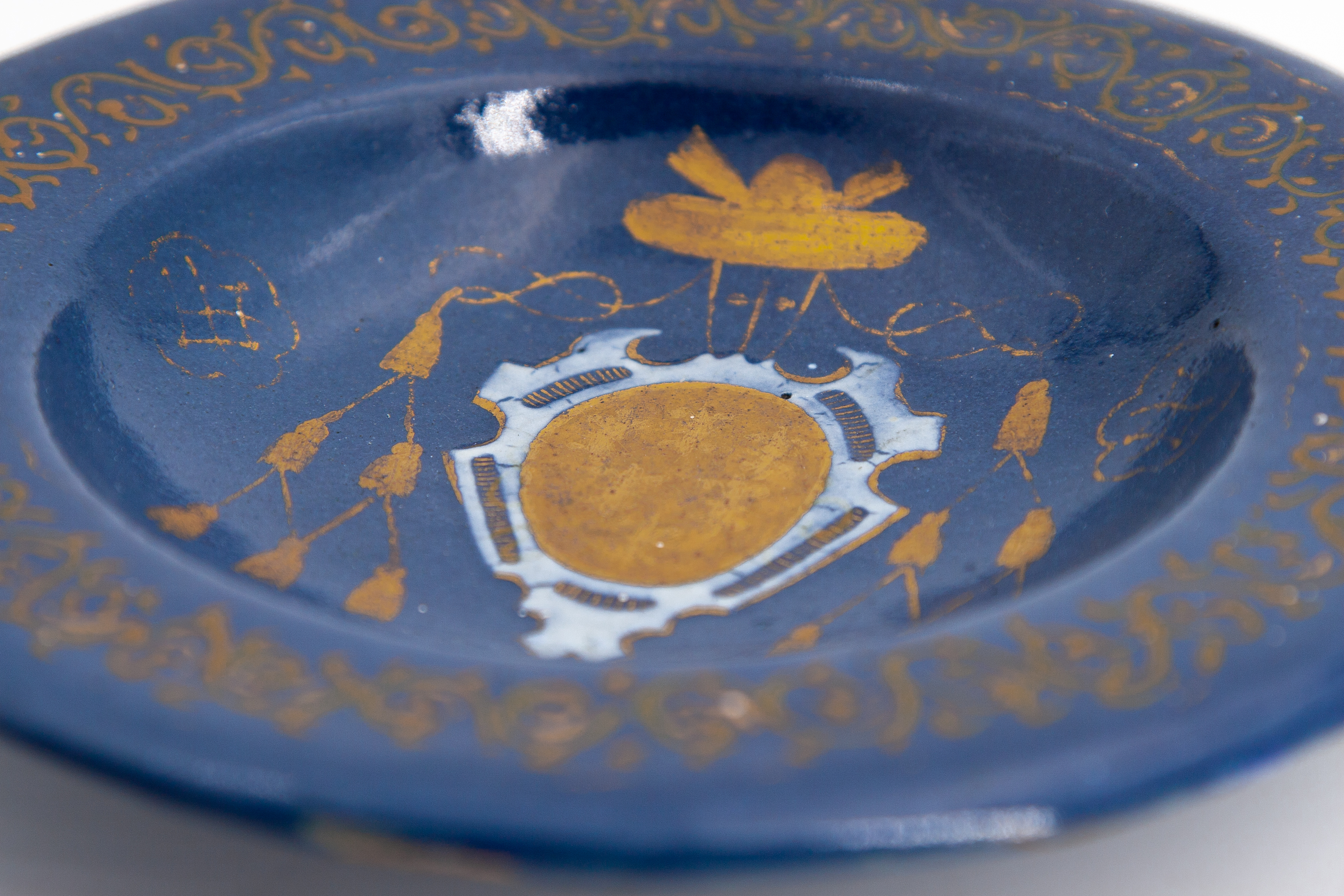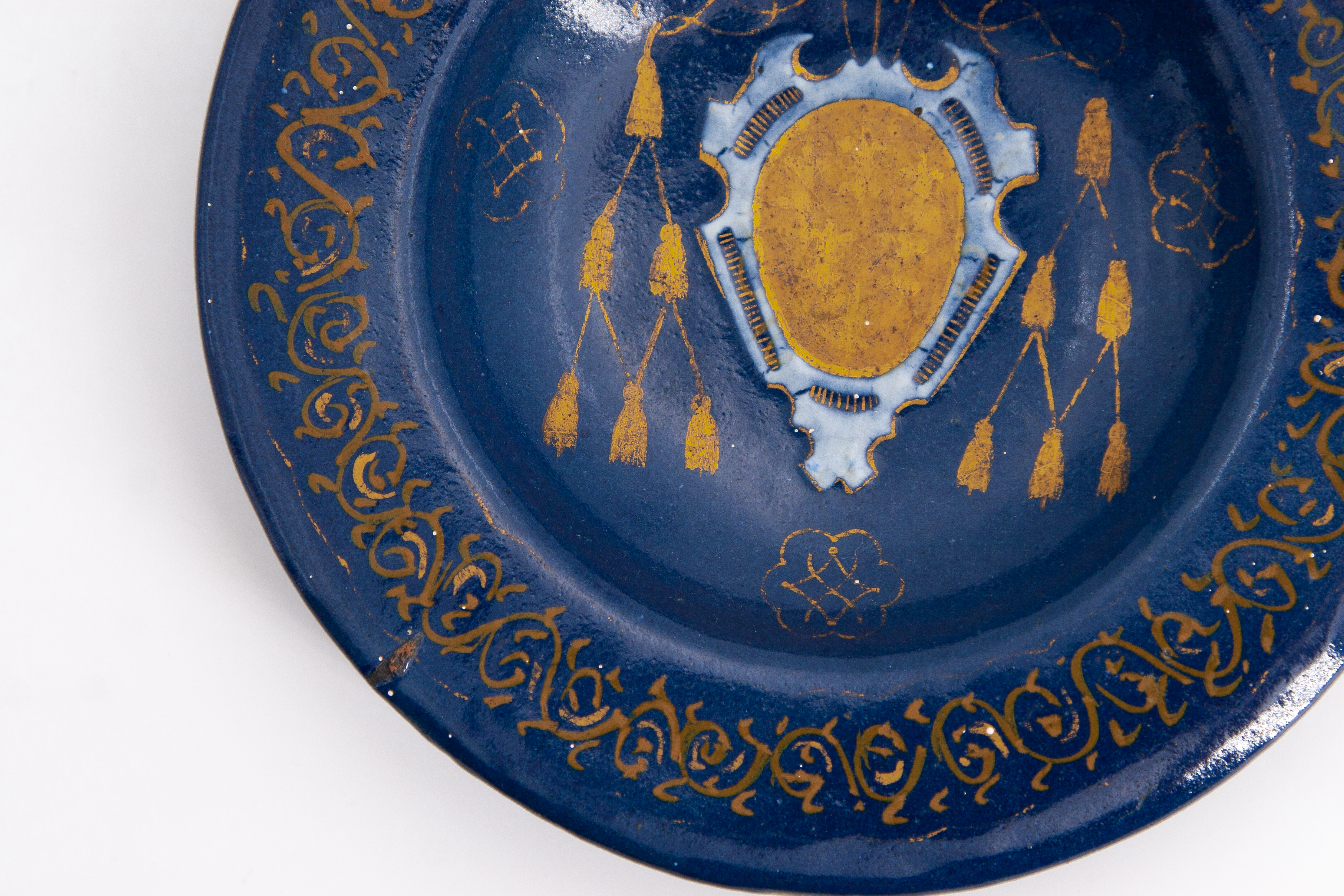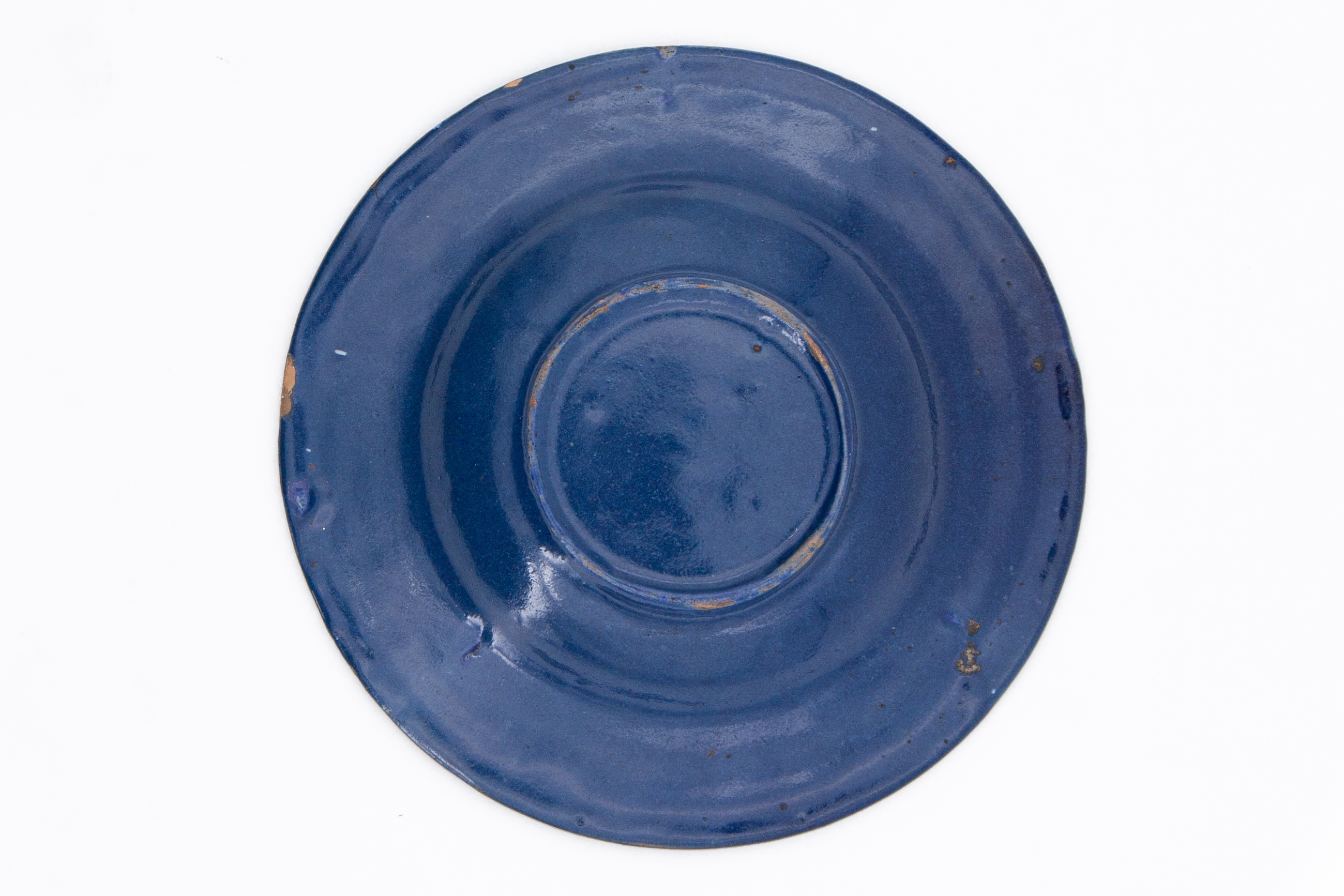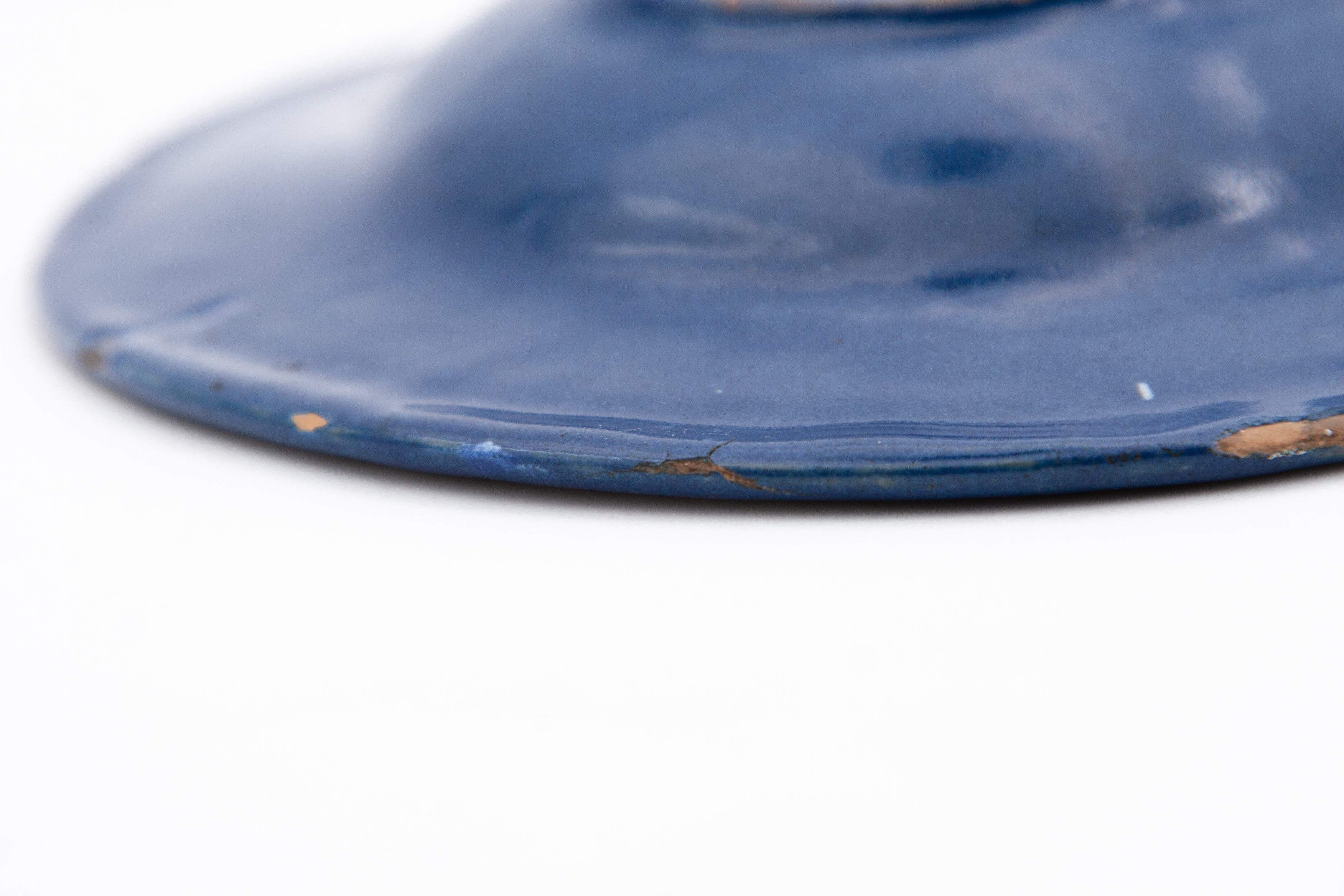In the peak of the High Renaissance, Cardinal Alessandro Farnese commissioned a dinner service from the Castelli maiolica manufactory in Abruzzo. Recorded in the inventories of the Palazzo Farnese in Rome in 1643 and 1653 as a credenza service of gold-decorated “Turchina” (or “Azure”) maiolica with the coat of arms of Cardinal Farnese, the unique blue-ground table-wares were intended to reflect the splendor of their owner and associate him with the grandeur of Ancient Rome.
In the peak of the High Renaissance, Cardinal Alessandro Farnese commissioned a dinner service from the Castelli maiolica manufactory in Abruzzo. Recorded in the inventories of the Palazzo Farnese in Rome in 1643 and 1653 as a credenza service of gold-decorated “Turchina” (or “Azure”) maiolica with the coat of arms of Cardinal Farnese, the unique blue-ground table-wares were intended to reflect the splendor of their owner and associate him with the grandeur of Ancient Rome.
Essay
“These were social values through which individuals sought to say something about themselves and to communicate that to others, thereby establishing their credentials as a new kind of elite, one of wealth, to be sure, but also one of taste and refinement.” -Richard Goldthwaite, 1989.
In the years leading up to the Italian Renaissance, several shifts in the Italian socio-economic landscape gave rise to new types of rulership. Cities began to grow significantly, people began to accumulate wealth alongside social mobility. Money, military might, and political leverage became the means by which families established power instead of claims to royal blood or divine virtue. As a result, public display of virtue became a necessity as much as it was a luxury, with the constant need to establish and solidify social placement.
The great palaces readily available for us today to visit in Italian cities such as Florence, Rome, and Venice were originally conceived as a public display of the Magnificence of their owner. As palaces grew bigger, they required new objects to fill them. In a fifteenth-century treatise on the display of social virtue, Giovanni Pontano notes Splendor as the conspicuous display of moral qualities through material possessions. Elite men and women in Renaissance Italy were expected to surround themselves with beautiful and rare things made with exquisite craftsmanship to reflect their own selves through them. It was all the better when these objects were tied to dining, a significant social event for display of personal virtue.
Cardinal Alessandro Farnese’s lifestyle was nothing short of princely. As the grandson of Pope Paul III and son of Pier Luigi Farnese (Duke of Parma), Alessandro Farnese was afforded a great fortune at a young age and became a renowned patron of the arts. Under his patronage, Alessandro employed only the greatest of Italian artists, including Titian (Portrait of Alessandro), Giacomo della Vignola (The Farnese Table), and Michelangelo, who designed the façade of the Palazzo Farnese in Rome on which we can today still find the same Farnese papal coat of arms as appears on the Farnese “alla Turchina” Plate.
A service of dinnerware for a credenza commissioned to decorate the Farnese palace in Rome is mentioned in the inventories of the Palazzo in 1643 and 1653 as “servitio da credenza di maiolica turchina miniata d’oro con arme del S.r cardinale Farnese” [credenza service of gold-decorated “Turchina,” or “Azure” maiolica with the coat of arms of Cardinal Farnese]. The unique blue-grounded table-wares are presumed to have been made in the Castelli ceramic manufactory in Abruzzo between 1574-1589 based on “C.rum 1574” marks on several earlier plates located today in other museum collections (an abbreviation of “Castellorum,” meaning “from Castelli” in Latin), and blue-ground material found in excavations in Abruzzo.
It comes as no surprise that “The Grand Cardinal” Alessandro Farnese would commission a dinner service from Castelli that was likely produced between 1574-1589. By the mid-16th century, Castelli was already a celebrated maker of maiolica. The Castelli manufactory was located in Abruzzo, Central Eastern Italy, then under the rule of the Aragonese Kingdom of Sicily. In 1556, Spanish Historian Pere Antoni Beuter compared the ceramics of Spain to those of Italy, and listed “the works of Castelli in the Sicilian valley of the Abruzzi” among the finest in Italy, alongside the ancient vases of Corinth, and the ceramics of “Corebæus, who according to Pliny was the inventor of pottery [lavorar la terra] in Athens”.
Cardinal Alessandro Farnese’s request for blue ground maiolica was a deliberate expression of wealth, power, and luxury. The most expensive paint pigment in the Renaissance was lapis lazuli, creating the rich and deep blue tones. Throughout the renaissance it was mostly reserved for adornment of the most important figures, such as the gown of the Virgin Mary seen as can be seen in Giotto’s Ognissanti Maesta or Agnolo Gaddi’s Madonna and Child with Saints. Moreover, Alessandro’s affinity towards blue pigment might well have come from his interest and involvement in archaeological excavations in Rome, a culture significantly appreciative of rich blue color, such as 2nd century faience Theatrical Masks. By owning and displaying this set of uniquely deep blue dishes, the cardinal was able to associate himself with the most illustrious figures of history as well as with the grand history of the Roman Empire, which he actively sought not only to emulate, but also to surpass.
Examples of these wares are included among masterpieces in the Ashmolean Museum, Oxford; Musei Civici Di Palazzo Farnese, Piacenza; Museo di Capodimonte in Naples; Pinacoteca di Varallo; and Palazzo Madama in Turin, where a similar plate with the coat of arms of Cardinal Alessandro Peretti di Montalto (1571-1623) tells us also how these wares became fashionable and desired statements by later generations.
MA
Condition
Excellent. Very light wear to the original 16th-century gilding. Two areas on glaze wear on the underside of the rim.
For a detailed condition report, please contact us.
Literature
Arbace, Luciana. Selected entires in “Gli oggetti d’arte di Casa Farnese” In I Farnese: arte e collezionismo, edited by Lucia Fornari Schianchi and Nicola Spinosa, 369-374. Milan: Electa, 1995.
Baxandall, Michael. Painting and Experience in Fifteenth Century Italy. Oxford, UK: Oxford University Press, 1988.
Beuter, Pere Antonio. Cronica generale di Spagna. Venice, 1556.
Fiocco, Carola, Gabriella Gherardi, and Giuseppe Matricardi. Capolavori della maiolica castellana dal Cinquecento al terzo fuoco: la collezione Matricardi. Torino: U. Allemandi & C., 2012.
Goldthwaite, Richard A. “The Economic and Social World of Italian Renaissance Maiolica.” Renaissance Quarterly 42, no. 1 (1989): 1-32.
Guidotti, Carmen Ravanelli. “Turchino Ware: The Birth and Establishment of a Taste for a Mannerist-Baroque Style” In Le Maioliche Cinquecentesche di Castelli: Una grande stagione artistica ritrovata, edited by 1989, pp. 126-140
Piontano, Giovanni. I trattat delle virtu sociali (Naples, 1485). Edited by Francesco Tateo. Rome: Edizioni dell’Ateneo, 1965.
Robertson, Clare. Il Gran Cardinale: Alessandro Farnese, Patron of the Arts. New Haven: Yale University Press, 1992.
Tateo, Francesco. Umanesimo etico di Giovanni Pontano. Lecce: Milella, 1972.
Wilson, Timothy, and Elisa Paola Sani. Le maioliche rinascimentali nelle collezioni della Fondazione Cassa di risparmio di Perugia, vol. II. Città di Castello (Perugia): Petruzzi, 2007.
References
Ashmolean Musuem, WA1888.CDEF.C506
Museo di Capodimonte, AM 10426-10497
Palazzo Madama, Turin, 3110/C and 3111/C
Pinacoteca di Varallo
Museo Civici di Palazzo Farnese, Piacenza
Cited Works
“These were social values through which individuals sought to say something about themselves and to communicate that to others, thereby establishing their credentials as a new kind of elite, one of wealth, to be sure, but also one of taste and refinement.” -Richard Goldthwaite, 1989.
In the years leading up to the Italian Renaissance, several shifts in the Italian socio-economic landscape gave rise to new types of rulership. Cities began to grow significantly, people began to accumulate wealth alongside social mobility. Money, military might, and political leverage became the means by which families established power instead of claims to royal blood or divine virtue. As a result, public display of virtue became a necessity as much as it was a luxury, with the constant need to establish and solidify social placement.
The great palaces readily available for us today to visit in Italian cities such as Florence, Rome, and Venice were originally conceived as a public display of the Magnificence of their owner. As palaces grew bigger, they required new objects to fill them. In a fifteenth-century treatise on the display of social virtue, Giovanni Pontano notes Splendor as the conspicuous display of moral qualities through material possessions. Elite men and women in Renaissance Italy were expected to surround themselves with beautiful and rare things made with exquisite craftsmanship to reflect their own selves through them. It was all the better when these objects were tied to dining, a significant social event for display of personal virtue.
Cardinal Alessandro Farnese’s lifestyle was nothing short of princely. As the grandson of Pope Paul III and son of Pier Luigi Farnese (Duke of Parma), Alessandro Farnese was afforded a great fortune at a young age and became a renowned patron of the arts. Under his patronage, Alessandro employed only the greatest of Italian artists, including Titian (Portrait of Alessandro), Giacomo della Vignola (The Farnese Table), and Michelangelo, who designed the façade of the Palazzo Farnese in Rome on which we can today still find the same Farnese papal coat of arms as appears on the Farnese “alla Turchina” Plate.
A service of dinnerware for a credenza commissioned to decorate the Farnese palace in Rome is mentioned in the inventories of the Palazzo in 1643 and 1653 as “servitio da credenza di maiolica turchina miniata d’oro con arme del S.r cardinale Farnese” [credenza service of gold-decorated “Turchina,” or “Azure” maiolica with the coat of arms of Cardinal Farnese]. The unique blue-grounded table-wares are presumed to have been made in the Castelli ceramic manufactory in Abruzzo between 1574-1589 based on “C.rum 1574” marks on several earlier plates located today in other museum collections (an abbreviation of “Castellorum,” meaning “from Castelli” in Latin), and blue-ground material found in excavations in Abruzzo.
It comes as no surprise that “The Grand Cardinal” Alessandro Farnese would commission a dinner service from Castelli that was likely produced between 1574-1589. By the mid-16th century, Castelli was already a celebrated maker of maiolica. The Castelli manufactory was located in Abruzzo, Central Eastern Italy, then under the rule of the Aragonese Kingdom of Sicily. In 1556, Spanish Historian Pere Antoni Beuter compared the ceramics of Spain to those of Italy, and listed “the works of Castelli in the Sicilian valley of the Abruzzi” among the finest in Italy, alongside the ancient vases of Corinth, and the ceramics of “Corebæus, who according to Pliny was the inventor of pottery [lavorar la terra] in Athens”.
Cardinal Alessandro Farnese’s request for blue ground maiolica was a deliberate expression of wealth, power, and luxury. The most expensive paint pigment in the Renaissance was lapis lazuli, creating the rich and deep blue tones. Throughout the renaissance it was mostly reserved for adornment of the most important figures, such as the gown of the Virgin Mary seen as can be seen in Giotto’s Ognissanti Maesta or Agnolo Gaddi’s Madonna and Child with Saints. Moreover, Alessandro’s affinity towards blue pigment might well have come from his interest and involvement in archaeological excavations in Rome, a culture significantly appreciative of rich blue color, such as 2nd century faience Theatrical Masks. By owning and displaying this set of uniquely deep blue dishes, the cardinal was able to associate himself with the most illustrious figures of history as well as with the grand history of the Roman Empire, which he actively sought not only to emulate, but also to surpass.
Examples of these wares are included among masterpieces in the Ashmolean Museum, Oxford; Musei Civici Di Palazzo Farnese, Piacenza; Museo di Capodimonte in Naples; Pinacoteca di Varallo; and Palazzo Madama in Turin, where a similar plate with the coat of arms of Cardinal Alessandro Peretti di Montalto (1571-1623) tells us also how these wares became fashionable and desired statements by later generations.
MA
Excellent. Very light wear to the original 16th-century gilding. Two areas on glaze wear on the underside of the rim.
For a detailed condition report, please contact us.
Arbace, Luciana. Selected entires in “Gli oggetti d’arte di Casa Farnese” In I Farnese: arte e collezionismo, edited by Lucia Fornari Schianchi and Nicola Spinosa, 369-374. Milan: Electa, 1995.
Baxandall, Michael. Painting and Experience in Fifteenth Century Italy. Oxford, UK: Oxford University Press, 1988.
Beuter, Pere Antonio. Cronica generale di Spagna. Venice, 1556.
Fiocco, Carola, Gabriella Gherardi, and Giuseppe Matricardi. Capolavori della maiolica castellana dal Cinquecento al terzo fuoco: la collezione Matricardi. Torino: U. Allemandi & C., 2012.
Goldthwaite, Richard A. “The Economic and Social World of Italian Renaissance Maiolica.” Renaissance Quarterly 42, no. 1 (1989): 1-32.
Guidotti, Carmen Ravanelli. “Turchino Ware: The Birth and Establishment of a Taste for a Mannerist-Baroque Style” In Le Maioliche Cinquecentesche di Castelli: Una grande stagione artistica ritrovata, edited by 1989, pp. 126-140
Piontano, Giovanni. I trattat delle virtu sociali (Naples, 1485). Edited by Francesco Tateo. Rome: Edizioni dell’Ateneo, 1965.
Robertson, Clare. Il Gran Cardinale: Alessandro Farnese, Patron of the Arts. New Haven: Yale University Press, 1992.
Tateo, Francesco. Umanesimo etico di Giovanni Pontano. Lecce: Milella, 1972.
Wilson, Timothy, and Elisa Paola Sani. Le maioliche rinascimentali nelle collezioni della Fondazione Cassa di risparmio di Perugia, vol. II. Città di Castello (Perugia): Petruzzi, 2007.
Ashmolean Musuem, WA1888.CDEF.C506
Museo di Capodimonte, AM 10426-10497
Palazzo Madama, Turin, 3110/C and 3111/C
Pinacoteca di Varallo
Museo Civici di Palazzo Farnese, Piacenza
This item ships free to the continental US, and globally for a flat-rate fee of $75.
All objects are packed with utmost care by our team of expert fine art shippers. All items are shipped with parcel insurance.
For more information on our shipping policies, please visit our FAQ Page.



















